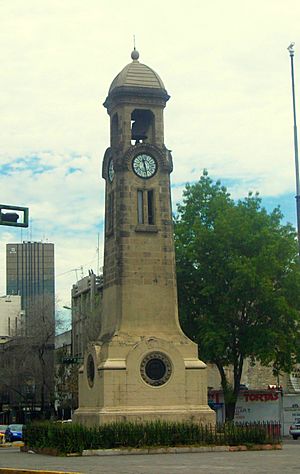Avenida Bucareli facts for kids
Avenida Bucareli, often called "Bucareli Street," is a major road in Mexico City. It's like a big highway that helps people get around. This avenue separates the Historic Center on the east from Colonia Juárez on the west.
The street is named after Antonio María de Bucareli y Ursúa. He was a viceroy, which was like a governor, of New Spain a long time ago. He was the one who asked for the street to be built.
Bucareli Avenue was created in the late 1700s. It was first called Paseo Nuevo. Back then, it was a very wide street with more than 1,000 ash trees lining its sides. In the 1800s, buildings were put up where the walking paths used to be. This made the avenue the width it is today. It originally had three public squares, each with a water fountain. Today, only one of those fountains remains. It was moved to a different spot called Plaza Loreto.
Contents
Cool Places on Bucareli Avenue
Bucareli Avenue is home to many interesting spots. Here are some of the most famous places you can find along this historic street:
Northern End: Glorieta del Caballito
- The northern part of Bucareli Avenue meets Paseo de la Reforma. This is another very famous street in Mexico City.
- At this meeting point is the Glorieta del Caballito. A "glorieta" is a roundabout. A famous statue of Charles IV of Spain on a horse, called "El Caballito," used to stand here.
Important Buildings
- Newspaper Buildings: You can see the buildings of two very important newspapers here. These are Excélsior, which started in 1923, and El Universal. These are places where news is written and printed every day.
- Secretariat of the Interior: This is a big government building. It's where important decisions about the country's internal affairs are made. It's a key part of the Mexican government.
- Edificio Gaona: Built in 1922, this is another notable building on the avenue.
- Edificio Vizcaya: Located at number 128, this is another interesting building to see.
Other Landmarks
- Café La Habana: This famous coffee shop opened in 1954. It's a great place to stop for a drink and feel the history.
- Reloj Chino (Chinese clock): This is a special clock that stands out on the avenue. It's a unique landmark.
- Conjunto Mascota: These are apartments where workers used to live. They were built by the person who started the El Buen Tono cigarette company. A famous architect named Miguel Ángel de Quevedo helped build them.
- Mercado Juárez: This is the local market for the Colonia Juárez neighborhood. It's a busy place where people buy food and other goods.
- Avenida Chapultepec: This is where Bucareli Avenue ends on its southern side.
See also
 In Spanish: Avenida Bucareli para niños
In Spanish: Avenida Bucareli para niños



